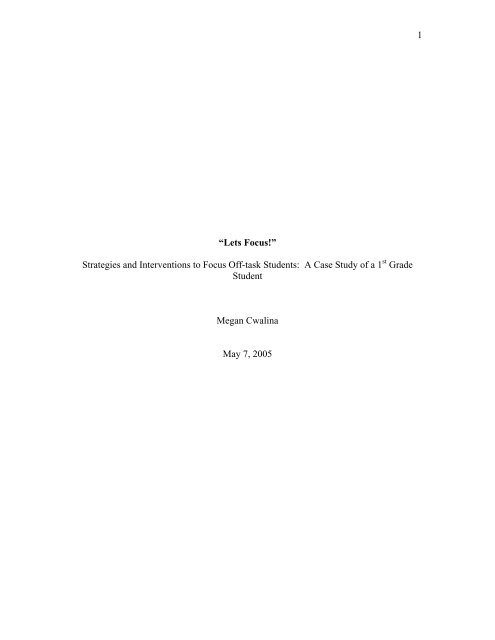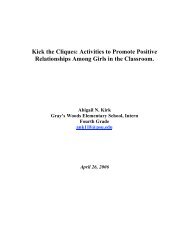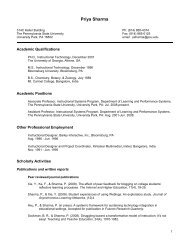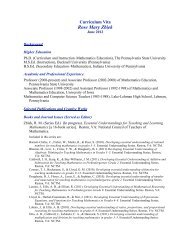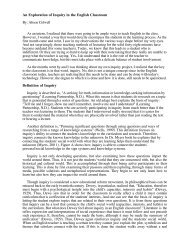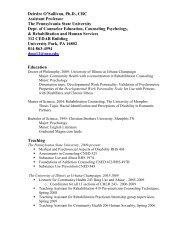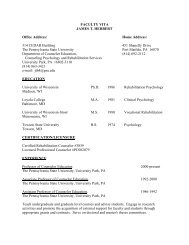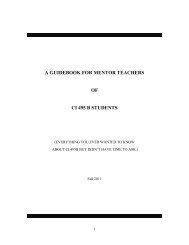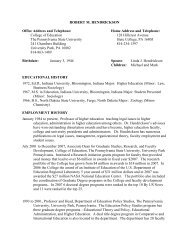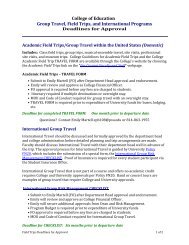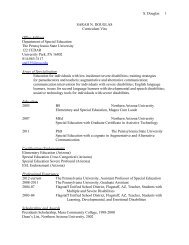Lets Focus! - the Penn State College of Education
Lets Focus! - the Penn State College of Education
Lets Focus! - the Penn State College of Education
Create successful ePaper yourself
Turn your PDF publications into a flip-book with our unique Google optimized e-Paper software.
“<strong>Lets</strong> <strong>Focus</strong>!”<br />
Strategies and Interventions to <strong>Focus</strong> Off-task Students: A Case Study <strong>of</strong> a 1 st Grade<br />
Student<br />
Megan Cwalina<br />
May 7, 2005<br />
1
Introduction<br />
Currently, I am a Pr<strong>of</strong>essional Development School Intern in a first grade<br />
classroom in <strong>the</strong> <strong>State</strong> <strong>College</strong> Area School District. The Pr<strong>of</strong>essional Development<br />
School is a partnership between The <strong>Penn</strong>sylvania <strong>State</strong> University and <strong>the</strong> school district.<br />
Through this year long internship I have had <strong>the</strong> experience <strong>of</strong> creating and implementing<br />
an inquiry project to explore a wondering about a particular child in my classroom.<br />
While working with my students, <strong>the</strong>re was one student in particular whose behavior and<br />
academic performance stood out. This student had difficulty paying attention and staying<br />
on task in both large and small group instruction. When working independently, this<br />
student frequently had difficulty staying on task and concentrating. In addition, he was<br />
having difficulty following directions, completing assignments, reading as well as<br />
processing information and making generalizations. In order to reach my goal <strong>of</strong> having<br />
every student achieve success, I began to wonder if <strong>the</strong>re were any strategies or<br />
interventions that could help this student stay on task and perform better academically.<br />
Accordingly, I began to perform research on Attention Deficit Disorder (ADD), Attention<br />
Deficit Hyperactivity Disorder (ADHD) as well as <strong>the</strong>ir connection with Sensory<br />
Disorders. This was helpful when determining what strategies or interventions would be<br />
best suited for this struggling student in my classroom. After collecting data about <strong>the</strong><br />
effectiveness and impact <strong>the</strong>se interventions had on this student, I have concluded several<br />
strategies that may be effective for many students that have difficulty staying in task in<br />
<strong>the</strong> classroom.<br />
2
My Initial Wonderings:<br />
♦ What strategies and interventions are successful for focusing <strong>of</strong>f-task students?<br />
♦ What strategies and interventions are successful for focusing students who have<br />
ADD/ADHD?<br />
♦ Are <strong>the</strong>se strategies or interventions going to be successful for <strong>the</strong> specific student<br />
in my classroom?<br />
Wonderings After Research and Observations:<br />
♦ Are <strong>the</strong>re connections between ADD/ADHD and sensory difficulties?<br />
♦ What strategies and interventions are helpful for students who are experiencing<br />
sensory difficulties?<br />
♦ Are <strong>the</strong>re connections between students who are easily distracted or have a<br />
difficulty focusing and low self-esteem?<br />
♦ How could I focus on this student’s strengths to improve his self-esteem and<br />
distractibility?<br />
♦ Would implementing sensory interventions help this student focus and improve<br />
on his distractibility?<br />
♦ How could I implement <strong>the</strong>se strategies or interventions so that <strong>the</strong>y wouldn’t<br />
draw attention to this particular student’s needs?<br />
♦ Would <strong>the</strong> o<strong>the</strong>r students in <strong>the</strong> classroom benefit from having some <strong>of</strong> <strong>the</strong><br />
interventions or strategies delivered to <strong>the</strong> entire class?<br />
♦ Is this student aware <strong>of</strong> his distractibility?<br />
♦ What activities are this student involved in at home and outside <strong>of</strong> school, and are<br />
<strong>the</strong> same issues present in those places?<br />
♦ Do <strong>the</strong> parents notice this student’s distractibility at home?<br />
3
What <strong>the</strong> Experts Say: Research<br />
What are <strong>the</strong> symptoms for ADD/ADHD?<br />
The symptoms for ADD/ADHD include impulsiveness, inattentiveness,<br />
hyperactivity, poor concentration or distractibility. The Diagnostic and Statistical<br />
Manual <strong>of</strong> Mental Disorders has noted patterns <strong>of</strong> behavior for ADD/ADHD. The<br />
Manual has divided ADD/ADHD into three categories or types; predominately<br />
hyperactive-impulse type, predominantly inattentive type and combined type. In order to<br />
be categorized with one type <strong>of</strong> ADD/ADHD, <strong>the</strong> student will need to show some<br />
symptoms before <strong>the</strong> age <strong>of</strong> seven, <strong>the</strong> symptoms must exist in more than one setting, <strong>the</strong><br />
symptoms interfere with child's functioning and <strong>the</strong> symptoms are not exclusive <strong>of</strong><br />
ano<strong>the</strong>r syndrome" (http://www.pediatricneurology.com/newpage11.htm).<br />
Fur<strong>the</strong>rmore, when a teacher considers <strong>the</strong> young students in his or her classroom,<br />
<strong>the</strong>re might seem to be several students who seem to be in constant motion, moving<br />
around in <strong>the</strong>ir seats or even just fidgety. Even though <strong>the</strong>re might be many students who<br />
are exhibiting those behaviors, <strong>the</strong>y are most likely not as prevalent. In fact, many young<br />
students exhibit those exact behaviors. Some students show symptoms for ADD/ADHD<br />
including impulsiveness, hyperactivity or even inattentiveness. However, when <strong>the</strong><br />
student's academic performance or social relationships with o<strong>the</strong>r students is impacted by<br />
<strong>the</strong> student's hyperactivity, lack <strong>of</strong> concentration, impulsiveness or lack <strong>of</strong> concentration,<br />
<strong>the</strong> student should be considered for a full evaluation for <strong>the</strong> appropriate diagnosis by a<br />
pr<strong>of</strong>essional.<br />
The hyperactive-impulsive type includes children who are unable to sit still in<br />
<strong>the</strong>ir seats, fidget with small objects or with self, "run, climb, or leave seat in situations<br />
where sitting or quiet behavior is expected," blurts out answers to questions or "having<br />
4
difficulty waiting in line or taking turns" (http:.//www.nimh.nih.gov/publicat/adhd.cfm).<br />
According to <strong>the</strong> Diagnostic and Statistical Manual <strong>of</strong> Mental Disorders, a student who<br />
has ADD/ADHD predominantly hyperactive-impulse type will exhibit <strong>the</strong> following<br />
symptoms:<br />
• Fidgets with hands or feet or squirms in chair.<br />
• Has difficulty remaining in seat.<br />
• Runs about or climbs excessively.<br />
• Difficulty engaging in activities quietly.<br />
• Acts as if driven by motor.<br />
• Talks excessively.<br />
• Blurts out answers before questions have been completed.<br />
• Difficulty waiting or taking turns.<br />
• Interrupts or intrudes upon o<strong>the</strong>rs.<br />
The predominately inattentive type includes students who do not have<br />
hyperactivity. These students display symptoms <strong>of</strong> inattentiveness or distractibility.<br />
According to <strong>the</strong> Diagnostic and Statistical Manual <strong>of</strong> Mental Disorders, a student who<br />
has ADD/ADHD predominantly inattentive type will exhibit <strong>the</strong> following symptoms:<br />
• Fails to give close attention to details or makes careless mistakes.<br />
• Has difficulty sustaining attention.<br />
• Does not appear to listen.<br />
• Struggles to follow through on instructions.<br />
• Has difficulty with organization.<br />
• Avoids or dislikes tasks requiring sustained mental effort.<br />
• Loses things.<br />
• Is easily distracted.<br />
• Is forgetful <strong>of</strong> daily activities.<br />
5
The third type <strong>of</strong> ADD/ADHD is <strong>the</strong> combined type. Students who are<br />
considered to have <strong>the</strong> combined type exhibit symptoms <strong>of</strong> both predominantly<br />
inattentive and predominantly hyperactive-impulse types.<br />
What impact does ADD/ADHD have on a student?<br />
ADD/ADHD is a syndrome that affects <strong>the</strong> way <strong>the</strong> brain functions. There are<br />
"three (brain) structures we've identified as being responsible for this disorder: <strong>the</strong> orbital<br />
prefrontal cortex; <strong>the</strong> striatum, part <strong>of</strong> <strong>the</strong> basal ganglia; and <strong>the</strong> caudate" (12,<br />
SchwabLearning.org). Unfortunately, <strong>the</strong>se areas <strong>of</strong> <strong>the</strong> brain are responsible for<br />
carrying out executive functions. Executive functions include things such as self-control<br />
and self-regulation. Because ADD/ADHS affects <strong>the</strong> executive functioning <strong>of</strong> a child,<br />
<strong>the</strong>re are developmental delays <strong>of</strong> inhibition. This developmental delay causes external<br />
events, people and noises around <strong>the</strong>m, and lack <strong>of</strong> foreseeing <strong>the</strong> future to take control<br />
over <strong>the</strong>ir every day functioning (21, SchwabLearning.org).<br />
O<strong>the</strong>r symptoms <strong>of</strong> executive dysfunction include lack <strong>of</strong> foresight or poor<br />
hindsight. These dysfunctions leave <strong>the</strong> child with ADD/ADHD to constantly be stuck in<br />
<strong>the</strong> present. These children have difficulty predicting <strong>the</strong> results <strong>of</strong> <strong>the</strong>ir behaviors and<br />
learning from <strong>the</strong>ir past behaviors to modify <strong>the</strong>ir actions. "The lack <strong>of</strong> this ability can be<br />
<strong>the</strong> most devastating part <strong>of</strong> ADHD" (http://www.pediatricneurology.com/newpage<br />
11.htm).<br />
In addition, <strong>the</strong>re are many o<strong>the</strong>r symptoms <strong>of</strong> executive dysfunction. Some o<strong>the</strong>r<br />
symptoms include poor organization, trouble returning to a task, poor sense <strong>of</strong> time or<br />
time moving too slowly and poor ability to use "self-talk" to work through a problem<br />
(http://www.pediatricneurology.com/newpage 11.htm). These symptoms could also have<br />
6
a great impact on <strong>the</strong> academic and social life <strong>of</strong> a child. Their poor organizational skills<br />
would pervade through <strong>the</strong>ir ma<strong>the</strong>matics, writing, handwriting and reading skills.<br />
Fur<strong>the</strong>rmore, <strong>the</strong> student who has difficulty returning to a task or a poor sense <strong>of</strong> time, <strong>the</strong><br />
student may not complete work on time, or even at all.<br />
O<strong>the</strong>r symptoms <strong>of</strong> executive dysfunction have an impact on a child's social or<br />
behavioral skills. Some <strong>of</strong> <strong>the</strong>se symptoms include having a poor internalization and<br />
generalization <strong>of</strong> rules, poor social clues, trouble transitioning, poor frustration tolerance<br />
and becoming angry frequently and quickly (http://www.pediatric neurology<br />
\.com/newpage 11.htm). These are <strong>the</strong> symptoms <strong>of</strong> executive dysfunction that cause for<br />
seventy-two percent <strong>of</strong> children with ADD/ADHD to argue with adults, sixty-six percent<br />
blame o<strong>the</strong>rs for <strong>the</strong>ir mistakes, seventy-one percent act touchy or are easily annoyed,<br />
forty percent swear, forty-nine percent lie, and fifty percent steal (http://www.<br />
pediatricneurology.com/newpage 11.htm).<br />
In addition to showing symptoms <strong>of</strong> executive dysfunction, many children with<br />
ADD/ADHD exhibit co-morbid disorders. These disorders accompany <strong>the</strong> diagnosis <strong>of</strong><br />
ADD/ADHD or <strong>the</strong>y are <strong>of</strong>ten misdiagnosed as ADD/ADHD. "John Ratey refers to<br />
<strong>the</strong>se as "shadow syndromes" (http://www.pediatricneurology.com/newpage 11.htm).<br />
What are <strong>the</strong> co-morbid disorders that <strong>of</strong>ten accompany ADD/ADHD?<br />
A co-morbid disorder that accompanies twenty to thirty percent <strong>of</strong> children who<br />
are diagnosed with ADD/ADHD, is a learning disability. Many <strong>of</strong> <strong>the</strong> characteristics <strong>of</strong> a<br />
learning disability are <strong>the</strong> same characteristics <strong>of</strong> ADD/ADHD. Difficulty following<br />
directions, sequencing or organizing problems and dysgraphia are all associated with<br />
learning disabilities and ADD/ADHD. According to Larry Silver, a child is tested for a<br />
7
learning disability when a student does not "live up to hi/her potential"<br />
(http://www.pediatricneurology.com/newpage 11.htm).<br />
O<strong>the</strong>r co-morbid disorders associated with ADD/ADHD are Disruptive<br />
Behavioral Disorders. These disorders account for fifty percent <strong>of</strong> children who are<br />
diagnosed with ADD/ADHD. Disruptive Behavioral Disorder includes behaviors such as<br />
lying, cursing, stealing, blaming o<strong>the</strong>rs for <strong>the</strong>ir mistakes as well as being easily angered<br />
or annoyed. As stated before, this disorder is a result <strong>of</strong> <strong>the</strong> executive dysfunction an<br />
ADD/ADHD child experiences. O<strong>the</strong>r Disruptive Behavioral Disorders include,<br />
Oppositional Defiant Disorder (ODD) where children are unwilling to conform, Conduct<br />
Disorder where children are "hostile and law breaking with a lack <strong>of</strong> remorse, " and<br />
Antisocial Personality Disorder (http://www.pediatricneurology.com/newpage 11.htm).<br />
In addition, Anxiety Disorder is ano<strong>the</strong>r co-morbid disorder that affects some<br />
children with ADD/ADHD. This disorder occurs in thirty percent <strong>of</strong> children with<br />
ADD/ADHD. These children experience stress from many situations. They may appear<br />
tense, edgy and may even be sleepless. Some children experience panic attacks when <strong>the</strong><br />
stressor becomes too overwhelming.<br />
Similarly, one third <strong>of</strong> ADD/ADHD patients have Obsessive Compulsive<br />
Disorder (OCD). These children experience obsessive thoughts and behaviors. In many<br />
instances, <strong>the</strong>se thoughts and behaviors can control <strong>the</strong>ir daily actions. However, in some<br />
instances children with OCD have been able to overcome <strong>the</strong> disorganization <strong>the</strong>y<br />
experience from ADD/ADHD (http://www.pediatricneurology.com/newpage 11.htm).<br />
Ano<strong>the</strong>r co-morbid disorder that <strong>of</strong>ten clusters with ADD/ADHD is Asperger's<br />
Syndrome. Children who have Asperger's Syndrome show symptoms including<br />
8
"impaired ability to utilize social cues such as body language,<br />
irony, or o<strong>the</strong>r"subtext" <strong>of</strong> communication; restricted eye contact<br />
and socialization; limited range <strong>of</strong> encyclopedic interests;<br />
perseverative, odd behaviors; didactic, monotone voice; "concrete"<br />
thinking; over-sensitive to certain stimuli; and unusual movements"<br />
(http://www.pediatric neurology.com/newpage 11.htm).<br />
Fur<strong>the</strong>rmore, Sensory Integration Dysfunction is a co-morbid disorder associated<br />
with ADD/ADHD. This dysfunction is <strong>the</strong> "inability to process information received<br />
through <strong>the</strong> senses" (http://www.pediatricneurology.com/newpage 11.htm). With this<br />
disorder, <strong>the</strong> child may be undersensitive or oversensitive to stimuli. Because <strong>the</strong>re are<br />
many symptoms that mimic <strong>the</strong> symptoms associated with ADD/ADHD, Sensory<br />
Integration Dysfunction is usually evaluated by an occupational <strong>the</strong>rapist. Some <strong>of</strong> <strong>the</strong><br />
symptoms include:<br />
• Hypersensitive to touch: sensitive to clo<strong>the</strong>s or getting dirty; withdraw to light<br />
kiss.<br />
• Hyposensitive to touch: wallow in mud; rub against things; unaware <strong>of</strong> pain.<br />
• Hypersensitive to movement: avoid running, climbing or swinging.<br />
• Hyposensitive to movement: rocking; twirling; unusual positions.<br />
• May also respond abnormally to sights, sounds, smells, tastes or textures.<br />
• May be clumsy; have trouble coordinating (bilateral) movements; or have poor<br />
fine motor skills.<br />
What are <strong>the</strong> serious consequences <strong>of</strong> ADD/ADHD?<br />
Depression could be a serious consequence <strong>of</strong> ADD/ADHD. In fact, depression<br />
could occur in ten to thirty percent <strong>of</strong> children and forty-seven percent <strong>of</strong> adults.<br />
Symptoms <strong>of</strong> depression could include "loss <strong>of</strong> joy, sadness, pervasive irritability,<br />
withdrawal, self0critical outlook, and vegetative symptoms (abnormal sleep or appetite)"<br />
9
(http://www.pediatricneurology.com/newpage 11.htm). In addition, secondary to <strong>the</strong><br />
students frustration with academic and social tasks, <strong>the</strong> student may lack self-confidence.<br />
How is ADD/ADHD diagnosed?<br />
Because ADD/ADHD has numerous co-morbid disorders, <strong>the</strong>re is not one single<br />
test to diagnose ADD/ADHD. The evaluation process requires time and effort. The<br />
evaluation includes a thorough family history, a clinical assessment <strong>of</strong> <strong>the</strong> student's<br />
"academic, social, and emotional functioning and developmental level" (http://www.<br />
chadd.org/fs/fs1.htm) The evaluation includes parents, teachers and possibly <strong>the</strong> student.<br />
The evaluations and assessments are age-normed tests that measure how extreme <strong>the</strong><br />
student's symptoms are.<br />
Many pr<strong>of</strong>essionals are included in <strong>the</strong> evaluation process; school psychologists,<br />
clinical psychologists, clinical social workers, nurse practitioners, neurologists,<br />
psychiatrists and pediatricians. Also included in <strong>the</strong> evaluation are <strong>the</strong> student, parents<br />
and <strong>the</strong> classroom teacher. In addition, <strong>the</strong> Diagnostic and Statistical Manual IV needs to<br />
be measured for ADD/ADHD criteria. Also, <strong>the</strong> child must be given a physical exam to<br />
rule out any medical problems that could be causing <strong>the</strong> symptoms for <strong>the</strong> child<br />
(http://www. chadd.org/fs/fs1.htm).<br />
Fur<strong>the</strong>rmore, <strong>the</strong> law is taken into consideration. "The Individuals with<br />
Disabilities Act (IDEA) <strong>of</strong> 1990 provides federal funding to school with guarantee<br />
special needs students with appropriate rights and services"<br />
(http://www.pediatricneurology.com/schoolrx.htm). In addition to providing an<br />
appropriate education for every student, <strong>the</strong>re are also guidelines for <strong>the</strong> evaluation<br />
process. For example, <strong>the</strong> parents <strong>of</strong> <strong>the</strong> student must be a part developing <strong>the</strong><br />
10
Individualized <strong>Education</strong> Plan (IEP) for <strong>the</strong> child. In addition, <strong>the</strong> parents must give<br />
consent for <strong>the</strong>ir child to be evaluated. However, <strong>the</strong> school has <strong>the</strong> right to decide when<br />
<strong>the</strong> evaluation is needed and appropriate. If <strong>the</strong> parents are not satisfied with <strong>the</strong> school<br />
district's evaluation team, <strong>the</strong>y may request an independent evaluation outside <strong>of</strong> <strong>the</strong><br />
school district. This IEP must be carried out by <strong>the</strong> school and <strong>the</strong> child's classroom<br />
teacher if necessary. There is also an annual review and updating <strong>of</strong> <strong>the</strong> child's IEP, and<br />
a full re-evaluation every three years. However, <strong>the</strong> parents may request a review any<br />
time <strong>the</strong>y feel necessary.<br />
How Did I Collect and Analyze My Data:<br />
In my classroom, I noticed one student who seemed to be very <strong>of</strong>f task for much<br />
<strong>of</strong> <strong>the</strong> day. At first I noticed how <strong>of</strong>ten I had to redirect <strong>the</strong> student or even give one-on-<br />
one attention during specific activities. I wanted to know how much <strong>of</strong> this student’s day<br />
was spent <strong>of</strong>f or on task, and what specific behaviors he was exhibiting.<br />
The first step I took to develop my inquiry in my classroom was meeting with <strong>the</strong><br />
Instructional Support Teacher at my school. She gave me some observation recording<br />
sheets that organized <strong>the</strong> data for time on/<strong>of</strong>f task. In addition, she gave me some<br />
suggestions for how to measure or collect time on/<strong>of</strong>f task data. She informed me that it<br />
<strong>of</strong>ten works better when you observe <strong>the</strong> student for one minute intervals.<br />
Taking <strong>the</strong> information that <strong>the</strong> IST teacher gave me, I also developed ano<strong>the</strong>r<br />
recording sheet. This recording sheet was used to document <strong>the</strong> behaviors that <strong>the</strong><br />
student exhibited during small group, large group and independent working situations.<br />
11
This recording sheet allowed me to explore where <strong>the</strong> student was having specific<br />
behavior inattentive difficulties.<br />
Next, I performed observations <strong>of</strong> my student. While my mentor was teaching<br />
lessons, I had <strong>the</strong> opportunity to examine and study <strong>the</strong> student. I instructed <strong>the</strong><br />
parapr<strong>of</strong>essional, my mentor teacher as well as my PDA on how to perform <strong>the</strong><br />
observations. In turn, <strong>the</strong>y were able to perform observations <strong>of</strong> my student while I was<br />
teaching lessons. In addition, I tried to monitor my actions while teaching a lesson; how<br />
many times I had to redirect <strong>the</strong> student, what comments I made toward <strong>the</strong> students, and<br />
how many times <strong>the</strong> student participated in <strong>the</strong> lesson or discussion.<br />
In addition to doing direct observing <strong>of</strong> my student, I also administered an<br />
informal student and parent survey. The student survey was designed to see what <strong>the</strong><br />
student enjoyed and disliked about school, if <strong>the</strong> student was aware <strong>of</strong> his distractibility<br />
as well as something he would like to do better at in school. I used <strong>the</strong> survey to collect<br />
information about <strong>the</strong> student's awareness <strong>of</strong> his distractibility. I was also able to<br />
pinpoint academic areas where <strong>the</strong> student felt he didn't perform very well. I used <strong>the</strong><br />
parent survey to see if <strong>the</strong> student was exhibiting any distraction or inattention at home. I<br />
also wanted to see if <strong>the</strong> parents noticed any <strong>of</strong> <strong>the</strong> behaviors at home that <strong>the</strong> student<br />
exhibited in class.<br />
After collecting all <strong>of</strong> my data through careful observations and <strong>the</strong> student and<br />
parent survey, I had to analyze <strong>the</strong> data. The first piece <strong>of</strong> data I analyzed was <strong>the</strong> student<br />
survey. From <strong>the</strong> survey, it was noted that <strong>the</strong> student likes school because it is fun,<br />
however <strong>the</strong>re are certain things that <strong>the</strong> student really does not like. I was able to<br />
conclude that <strong>the</strong> student did not like any activities where writing was involved. In fact,<br />
12
<strong>the</strong> student shared that he felt nervous when he could tell a writing activity was coming<br />
up. From <strong>the</strong> student survey I also learned that <strong>the</strong> student is aware <strong>of</strong> his distractibility.<br />
I asked <strong>the</strong> question, "do you think that sometimes it is hard for you to pay attention<br />
during class, why or why not?" The student responded by saying, "Yea, <strong>the</strong>re are a lot <strong>of</strong><br />
pretty cool things around that you could use. We mostly have to do a lot <strong>of</strong> writing and I<br />
can spot that coming." I was able to conclude that <strong>the</strong> student knows that he is distracted<br />
by <strong>the</strong> things that are all around <strong>the</strong> room, and that he allows himself to become<br />
distracted when he thinks <strong>the</strong>re is a writing activity approaching.<br />
When analyzing <strong>the</strong> parent survey, it was concluded that <strong>the</strong> student also exhibits<br />
some distractibility at home as well. The parent shared that <strong>the</strong>ir son has trouble<br />
following directions at home, and sometimes needs to be told several times what <strong>the</strong><br />
directions are. Fur<strong>the</strong>rmore, <strong>the</strong>y also felt that <strong>the</strong>ir son's nervousness when completing<br />
tasks was a behavior that was out <strong>of</strong> <strong>the</strong> ordinary.<br />
After contemplating <strong>the</strong> results <strong>of</strong> <strong>the</strong> two surveys, I was anxious to analyze <strong>the</strong><br />
observational data that was collected. The computation <strong>of</strong> this data was done in several<br />
ways. I tallied <strong>the</strong> number <strong>of</strong> <strong>of</strong>f/on task behaviors during small group, large group, and<br />
independent instruction. The comparison <strong>of</strong> <strong>the</strong>se two numbers was employed to see if<br />
<strong>the</strong> student spent more time on <strong>of</strong>f-task activities. Also, I inquired into <strong>the</strong> specific<br />
behaviors <strong>the</strong> student was engaging in while he was <strong>of</strong>f-task. The number <strong>of</strong> different<br />
behaviors was tallied to see what <strong>the</strong> majority <strong>of</strong> <strong>the</strong> behaviors were.<br />
After looking over <strong>the</strong> observation sheet and annotated notes, I tallied all <strong>of</strong> <strong>the</strong><br />
<strong>of</strong>f/on task behaviors <strong>the</strong> student engaged in during a large group instruction. I<br />
discovered that <strong>the</strong> student exhibited one hundred five <strong>of</strong>f-task behaviors compared to<br />
13
twenty one on-task behaviors. When I tallied <strong>the</strong> on/<strong>of</strong>f task behaviors for small group<br />
instruction, I noted twenty <strong>of</strong>f-task behaviors compared to 30 on-task behaviors. Lastly, I<br />
tallied on/<strong>of</strong>f task behaviors exhibited during independent work and discovered forty <strong>of</strong>f-<br />
task behaviors compared to five on-task behaviors.<br />
From this data and analysis, I have discovered that this student has great difficulty<br />
remaining on task during large group instruction and independent work. The results were<br />
shocking. I never realized how many <strong>of</strong>f-task behaviors this student exhibited. I was<br />
surprised to find out that this student engaged in more on-task activities compared to <strong>of</strong>f-<br />
task activities during small group instruction.<br />
In addition to <strong>the</strong> above mentioned data, o<strong>the</strong>r behaviors this student exhibited<br />
were documented and compiled. From this analysis, it was noted that <strong>the</strong> student<br />
engaged in behaviors including biting his nails, picking his nose, blank staring, playing<br />
with small objects, slapping hands as well as rocking his body. These results were very<br />
interesting due to <strong>the</strong> fact that most <strong>of</strong> <strong>the</strong>se behaviors if not all, had to deal with sensory<br />
issues, which is common with ADD/ADHD.<br />
Due to <strong>the</strong> fact that many <strong>of</strong> my student's behaviors included sensory issues,<br />
distractibility and inattentiveness I thought that it might be beneficial to implement<br />
strategies and interventions that experts suggest for students who have ADD/ADHD.<br />
After referring back to my research about interventions that focus on <strong>the</strong> specific<br />
behaviors my student exhibits. It was imperative that I chose interventions that focused<br />
on sensory issues, inattentiveness, distractibility as well as improvement <strong>of</strong> self-esteem.<br />
Finally, I had to take into careful consideration how and when to implement <strong>the</strong>se<br />
strategies in order to collect data to explore <strong>the</strong> effectiveness <strong>of</strong> <strong>the</strong> specific intervention.<br />
14
What Interventions Did I Implement?<br />
Clear Rules, Expectations and Organization:<br />
A major impairment <strong>of</strong> students who have ADD/ADHD is with <strong>the</strong> execution <strong>of</strong><br />
executive functions. Many <strong>of</strong> <strong>the</strong>se executive functions deal with poor organizational<br />
skills, poor internalization and generalization <strong>of</strong> rules as well as having trouble<br />
transitioning (http://www.pediatricneurology.com/newpage11.htm). Because <strong>the</strong>se<br />
functions are difficult with students who have ADD/ADHD, setting clear rules,<br />
displaying <strong>the</strong> rules, giving examples <strong>of</strong> rules and making rules so that <strong>the</strong>y are<br />
observable could be helpful for students.<br />
In <strong>the</strong> beginning <strong>of</strong> <strong>the</strong> school year, we set clear classroom rules that <strong>the</strong> students<br />
helped to create. The rules were created so that <strong>the</strong>y would be observable by <strong>the</strong> students.<br />
In addition, we also gave specific examples <strong>of</strong> how to follow those rules. In addition to<br />
setting clear rules in my classroom, we utilized <strong>the</strong> first two weeks <strong>of</strong> school to learn how<br />
to move through transitioning periods throughout <strong>the</strong> day. There were clear, concise<br />
directions on how to go through <strong>the</strong> different transitions. Fur<strong>the</strong>rmore, <strong>the</strong> students had<br />
many opportunities to practice going through <strong>the</strong> transitions. Also, <strong>the</strong> classroom was<br />
very organized and <strong>the</strong> students had <strong>the</strong> opportunity to explore and learn <strong>the</strong> rules for <strong>the</strong><br />
different materials organized around <strong>the</strong> classroom. Not only is this an important thing to<br />
do for students who have ADD/ADHD, but it is also helpful for every o<strong>the</strong>r student in <strong>the</strong><br />
classroom to learn as well.<br />
15
Stop, Look and Listen<br />
This intervention was established from <strong>the</strong> first day <strong>of</strong> school. However, I made a<br />
great attempt to make sure that every student, especially my case study student, was<br />
stopping, looking and listening. In my classroom, I set a clapping pattern that I would<br />
start and <strong>the</strong> students would finish. The students are given specific instructions to stop<br />
what <strong>the</strong>y are doing, do something with <strong>the</strong>ir hands, have <strong>the</strong>ir eyes on <strong>the</strong> teacher and be<br />
listening for <strong>the</strong> directions or instructions. For example, during literacy centers, when it<br />
came time to transition and <strong>the</strong> students needed to listen to <strong>the</strong> directions about how to<br />
move from center to center, I would initiate <strong>the</strong> clapping pattern and have <strong>the</strong> students<br />
finish it. Next, I would tell <strong>the</strong> students to put <strong>the</strong>ir hands in <strong>the</strong>ir air, <strong>the</strong>n on <strong>the</strong>ir head,<br />
and <strong>the</strong>n to keep <strong>the</strong>ir hands <strong>the</strong>re while <strong>the</strong>y are looking and listening while I gave<br />
directions.<br />
Having <strong>the</strong> students stop, look and listen forces <strong>the</strong> students to make sure that<br />
<strong>the</strong>y are stopping whatever it is that <strong>the</strong>y are doing and really concentrating on listening<br />
to <strong>the</strong> next set <strong>of</strong> directions. This intervention is especially helpful for <strong>the</strong> student who<br />
has trouble attending to directions. It forces that student to focus on one thing; listening<br />
to <strong>the</strong> directions, and not allow him to be distracted by any outside stimuli.<br />
In addition to <strong>the</strong> clapping pattern I made sure that <strong>the</strong> students were listening to<br />
all directions I given, especially during a direct instructional activity. Before I began<br />
giving directions, I would make sure that every student had <strong>the</strong> materials out that <strong>the</strong>y<br />
needed to complete <strong>the</strong> activity. Then, I would have students place <strong>the</strong>ir pencils on <strong>the</strong><br />
floor so that <strong>the</strong> students were concentrating on what I was saying, ra<strong>the</strong>r than writing or<br />
being distracted by <strong>the</strong>ir pencils. This intervention was created with my case study<br />
16
student in mind. Because he was constantly being distracted by playing with his pencil,<br />
tapping it, playing with <strong>the</strong> erase or even doodling on his desk, I felt this was a very<br />
important intervention to help focus <strong>the</strong> student.<br />
Appropriate Seating Arrangement:<br />
After analyzing <strong>the</strong> data and observations, I discovered that my case study student<br />
was very distracted by sensory stimuli. He was <strong>of</strong>ten distracted by noise, movement,<br />
physical contact with self and objects as well as visual stimuli. Therefore, I seated him in<br />
an area in <strong>the</strong> classroom that would not have a lot <strong>of</strong> sensory stimulation. I created a spot<br />
in <strong>the</strong> classroom where he would not be able to look out <strong>the</strong> window or near <strong>the</strong> door to<br />
<strong>the</strong> classroom. In addition, it has been noted that proximity control is also very important<br />
to keep students who have ADD/ADHD on task. Therefore, I placed him towards <strong>the</strong><br />
front <strong>of</strong> <strong>the</strong> room, where I usually deliver directions and whole group lessons. The<br />
student had <strong>the</strong> optimum seating arrangement void <strong>of</strong> excessive sensory stimuli as well as<br />
having close proximity to <strong>the</strong> teacher.<br />
In addition to seating arrangements, I also thought that it would be important for<br />
<strong>the</strong> student to sit in close proximity to <strong>the</strong> teacher during large group instruction as well<br />
as small group instruction. Because <strong>the</strong> student exhibited so many <strong>of</strong>f-task behaviors<br />
during large group instruction, I was hoping that those behaviors would be lessened if he<br />
was sitting much closer to <strong>the</strong> teacher. With <strong>the</strong> close proximity to <strong>the</strong> teacher, <strong>the</strong><br />
student might be less distracted or become more conscious that <strong>the</strong> teach could observe<br />
his actions.<br />
17
Small Sensory Ball:<br />
After hearing a presentation by an occupational <strong>the</strong>rapist about students who have<br />
sensory issues, I contemplated integrating sensory interventions. Due to <strong>the</strong> fact that<br />
most <strong>of</strong> <strong>the</strong> behaviors my student was exhibiting were sensory related, it was essential to<br />
implement an intervention suggested by <strong>the</strong> occupational <strong>the</strong>rapist. The <strong>the</strong>rapist<br />
suggested giving <strong>the</strong> distractible student something to manipulate or touch in <strong>the</strong>ir hands<br />
while <strong>the</strong>y were listening to directions or working in a large group setting. She suggested<br />
that this would focus <strong>the</strong> student because he/she would not be craving that o<strong>the</strong>r sensory<br />
stimulation that <strong>the</strong> student was usually engaged in.<br />
Subsequently, I gave my case study student a small yellow, suction cup ball. The<br />
student was informed that <strong>the</strong>re were three rules for holding <strong>the</strong> ball: only hold <strong>the</strong> ball<br />
in one hand, do not throw or drop <strong>the</strong> ball, and always be looking and focusing in on <strong>the</strong><br />
teacher when you have <strong>the</strong> ball in your hand. The student was instructed to recite <strong>the</strong><br />
rules back to me in order to make sure that he heard and understood <strong>the</strong> rules. The<br />
student was given <strong>the</strong> ball whenever we were in a large group instructional setting or<br />
when <strong>the</strong>re were going to be specific instructions or directions given.<br />
Praise Journal:<br />
After observing my case study student come into school in <strong>the</strong> mornings with a<br />
scow on his face, and discovering that he did not like school very much, I decided to<br />
implement a praise journal. I decorated <strong>the</strong> journal with <strong>the</strong> student's favorite colors and<br />
I wrote encouraging comments on it. At first, I told <strong>the</strong> student that we were going to do<br />
something special that was just between him and me. At <strong>the</strong> end <strong>of</strong> each day he would<br />
18
tell me two things that he felt he did well during <strong>the</strong> day, and I would also write down a<br />
comment or compliment about something I noticed he did well with during <strong>the</strong> day. I<br />
made sure that <strong>the</strong> he knew that this was only between us, and he wasn't to tell <strong>the</strong> o<strong>the</strong>r<br />
students about it. I also instructed him to be thinking about what he is doing well<br />
throughout <strong>the</strong> day. Every day we would write down <strong>the</strong> comments and he would choose<br />
a sticker to place on <strong>the</strong> page. The student took <strong>the</strong> praise journal home on <strong>the</strong> weekends<br />
so his parents could document things <strong>the</strong>y noticed him doing well at home. The goal <strong>of</strong><br />
this intervention was to improve <strong>the</strong> student's self-esteem and his outlook on school. This<br />
was a wonderful instrument for positive reinforcement and encouraging comments.<br />
Movement:<br />
I carefully monitored how long my students were sitting still, listening to a lesson.<br />
I also know that young children have very short attention spans. Therefore, I thought it<br />
would be important, especially to my case study student, to have <strong>the</strong> students engage in a<br />
short activity that got <strong>the</strong>m up out <strong>of</strong> <strong>the</strong>ir seats and moving. I would have <strong>the</strong> students<br />
stand up by <strong>the</strong>ir desks and do a short stretching exercise with me. In addition, music and<br />
songs were played and <strong>the</strong> students acted out <strong>the</strong> motions that accompanied <strong>the</strong> words.<br />
This gave students a small break from listening and focusing to get out some <strong>of</strong> <strong>the</strong>ir pent<br />
up energy. Participating in this was particularly important for my case study was usually<br />
moving a part <strong>of</strong> his body in some way; tapping, rocking, bobbing his head. It got out<br />
some <strong>of</strong> that energy that might have been spent during <strong>the</strong> lesson.<br />
19
What Did I Learn From My Inquiry?:<br />
When <strong>the</strong> physical environment in <strong>the</strong> classroom, especially seating<br />
arrangement, is taken into consideration, <strong>the</strong> special needs <strong>of</strong> distractible students can<br />
be accommodated. When a student is highly distractible, especially to sensory stimulants,<br />
it is important to consider <strong>the</strong>ir seating arrangement in <strong>the</strong> classroom. "To minimize<br />
distractions, seat <strong>the</strong> ADD/ADHD student away from both <strong>the</strong> hallway and <strong>the</strong> windows"<br />
(http://www.addinschool.com/elemntary/roomsetup.htm). For students who have<br />
difficulty with too much sensory input, a colorful classroom filled with pictures,<br />
children's work and colorful bulletin boards can be distracting to a student with sensory<br />
input issues. According to Schneider, "many people believe that learning will take place<br />
more quickly in an environment with lots <strong>of</strong> visual stimulation to capture <strong>the</strong> attention.<br />
However, for <strong>the</strong> child with a visual perceptual overload, it can be distracting and<br />
difficult to work in such a room" (80, Schneider). Therefore, it is important to seat <strong>the</strong><br />
student in a location with <strong>the</strong> least amount <strong>of</strong> visual and auditory distractions.<br />
In addition, when <strong>the</strong> student was observed in a new seating location; closer to <strong>the</strong><br />
teacher, away from extraneous stimuli, <strong>the</strong> student appeared less distracted or exhibited<br />
various activities that he did in a previous seating arrangement. When observed in a large<br />
group setting where he was sitting in close proximity to <strong>the</strong> teacher, he exhibited more<br />
on-task behaviors than <strong>of</strong>f-task ones. Fur<strong>the</strong>rmore, when <strong>the</strong> student was asked if he felt<br />
more or less distracted in his new seating arrangement, <strong>the</strong> student responded by stating<br />
that he felt, "much less distracted because he had to focus on <strong>the</strong> teacher."<br />
20
When clear two to three step instructions are given after <strong>the</strong> students "stop,<br />
look and listen," students are more likely to understand and follow directions. It is<br />
difficult for children to attend to more than one thing. This is especially true for students<br />
who have to attend to more than one thing at a time. When students are forced to stop<br />
what <strong>the</strong>y are doing, look at <strong>the</strong> teacher and listen, <strong>the</strong>y only have to attend to one thing;<br />
what <strong>the</strong> teacher is saying. This technique is especially important to focus those students<br />
who are easily distracted. In addition, while you have that student's attention, it is<br />
important to give clear, two step directions. Because <strong>the</strong> student has a difficult time<br />
attending, you want to make <strong>the</strong> directions as clear and concise as possible. This is<br />
important because you may only have that student's attention for a short amount <strong>of</strong> time.<br />
You want <strong>the</strong> student to hear and comprehend what it is that you want <strong>the</strong>m to do and<br />
learn.<br />
Positive praise has an impact on a student's self-esteem, class participation and<br />
motivation to complete academic tasks well. Because students with ADD/ADHD have<br />
trouble completing many demanding tasks at once, <strong>the</strong>refore <strong>the</strong> "resulting anxiety can<br />
lead to a diminished self-esteem" (http://www.arp.sprnet.org/curric/ATRISK/adhd.htm).<br />
This diminished self-esteem has been prevalent with my case study student. He began to<br />
express dislike <strong>of</strong> school and looking forward to <strong>the</strong> weekends. In addition, I observed<br />
<strong>the</strong> student coming into school with a scow on his face. He <strong>of</strong>ten expressed that he<br />
wanted to go home and not be in school. As previously noted, <strong>the</strong> results <strong>of</strong> <strong>the</strong> survey<br />
expressed his concern and fear about writing.<br />
21
However, after three weeks <strong>of</strong> writing put ups in a praise journal every day, <strong>the</strong>re<br />
has been a remarkable change in attitude and academic achievement. Every day, my case<br />
study student would tell me two things that he thought he did really well during <strong>the</strong> day.<br />
I would also write down a comment about something I noticed him doing well during <strong>the</strong><br />
day. In addition, he was allowed to pick a sticker and place it on <strong>the</strong> page.<br />
I observed <strong>the</strong> student in various situations throughout <strong>the</strong> day; large and small<br />
group instruction, independent work as well as socially. This student began coming to<br />
school with a smile on his face. He also began to raise his hand and respond during large<br />
and small group instruction. In fact, he rose his hand forty-three times in one week,<br />
compared to my initial observations where he only rose his hand eight times in one week.<br />
In addition, this student began working independently and spent more time on-task than<br />
<strong>of</strong>f-task. This is in great contrast to my initial observations. Fur<strong>the</strong>rmore, <strong>the</strong> student's<br />
writing and ma<strong>the</strong>matics tasks have improved greatly. A comparison <strong>of</strong> a writing and<br />
math sample taken during my initial observations, with samples taken after <strong>the</strong><br />
intervention <strong>of</strong>fer great evidence for <strong>the</strong> impact <strong>of</strong> giving a student positive praise.<br />
In addition, according to ADD In School.com,<br />
"encouraging your student to monitor his own behavior has<br />
many benefits. It can provide opportunity for discussion<br />
when your student and <strong>the</strong> teacher agree/disagree on <strong>the</strong><br />
ratings. It also prompts movement toward your student's<br />
internal frame <strong>of</strong> reference in evaluating his behavior"<br />
(http://www.addinschool.com/elementary/compliance.htm).<br />
Most importantly, I overheard <strong>the</strong> student state that “he was really going to miss<br />
school on Saturday and Sunday!”<br />
22
Distractible students, especially those with sensory distractions, benefit from<br />
sensory input interventions including a tactile ball as well as movement activities.<br />
Many students, especially those students who are diagnosed with ADD/ADHD, or even<br />
those who exhibit ADD/ADHD symptoms- such as my case study student- are constantly<br />
in motion. They may move around <strong>the</strong> classroom, fidget in <strong>the</strong>ir seats or play with small<br />
objects. Having <strong>the</strong>se students get up out <strong>of</strong> <strong>the</strong>ir seat and engage in a structured<br />
movement activity can help students focus better on tasks. In fact, according to Carla<br />
Hannaford, "<strong>the</strong> more closely we consider <strong>the</strong> elaborate interplay <strong>of</strong> brain and body, <strong>the</strong><br />
more clearly one compelling <strong>the</strong>me emerges: movement is essential to learning" (41<br />
Schneider).<br />
In addition, when given a sensory input (a suction cup ball), my case study<br />
student was able to hold <strong>the</strong> ball in his hands and completely focus on <strong>the</strong> teacher. After<br />
careful explanation <strong>of</strong> <strong>the</strong> rules and purpose for maintaining <strong>the</strong> ball, <strong>the</strong> student was<br />
able to control his actions and use <strong>the</strong> ball in a positive way. I noticed <strong>the</strong> student was<br />
able to understand and follow directions better when he was holding <strong>the</strong> ball in his hand<br />
while <strong>the</strong> directions were being given, compared to how he followed directions without<br />
<strong>the</strong> ball in hand. Fur<strong>the</strong>rmore, it is important to "create tasks that engage both hands in<br />
accomplishing <strong>the</strong> desired activity (following directions)" (72, Schneider).<br />
Conclusions, Future Teaching Implications, New Wonderings:<br />
I have discovered <strong>the</strong> joy <strong>of</strong> helping a student whose needs are not being met in<br />
<strong>the</strong> classroom. I have learned that it is important to perform careful observations and to<br />
analyze those observations to get to <strong>the</strong> source <strong>of</strong> <strong>the</strong> problem a student may be<br />
23
struggling with. Once you have an idea about what that child might be struggling with, it<br />
is important to perform research and contact o<strong>the</strong>r pr<strong>of</strong>essional and parents to ga<strong>the</strong>r<br />
more information. I have also learned that with research, careful planning <strong>of</strong><br />
interventions, executing <strong>the</strong> interventions and <strong>the</strong>n carefully analyzing <strong>the</strong> intervention's<br />
effectiveness, you could greatly impact a student.<br />
Fur<strong>the</strong>rmore, I have discovered some strategies that are successful not only for<br />
students who have attention problems, but for all <strong>of</strong> <strong>the</strong> students in <strong>the</strong> classroom. The<br />
implementation <strong>of</strong> many <strong>of</strong> <strong>the</strong>se strategies from <strong>the</strong> first day <strong>of</strong> school can help students<br />
focus, remain on task and enjoy school with minimal frustration. The excitement and <strong>the</strong><br />
knowledge <strong>of</strong> how <strong>the</strong>se effect my student as well as my classroom will certainly benefit<br />
me and my students in future endeavors. In all probability, I will have several students in<br />
<strong>the</strong> future who will experience difficulties with distractibility or even be diagnosed with<br />
ADD/ADHD. However, I am confident that I will be able to help <strong>the</strong>se students achieve<br />
success by implementing <strong>the</strong>se interventions.<br />
I am still wondering what are some o<strong>the</strong>r strategies or interventions that help<br />
students who have sensory distractibility. I am also wondering if my case study student<br />
will be diagnosed with ADD/ADHD and if he has any sensory input disorders. Also,<br />
what would be <strong>the</strong> next step to maintain progress in this student. In addition, I am<br />
wondering <strong>the</strong> impact a praise journal would have on every student in <strong>the</strong> classroom, and<br />
<strong>the</strong>ir self-esteem and academic performance.<br />
In conclusion, <strong>the</strong> students, his parents and <strong>the</strong> support staffs willingness to work<br />
with new strategies and interventions, enabled me to see him, not just as ano<strong>the</strong>r student,<br />
but as a young person with so many terrific qualities, who is willing to learn and feel<br />
24
good about himself. After all, “a teacher affects eternity: she can never tell where her<br />
influence stops.”- Henry Adams<br />
25


